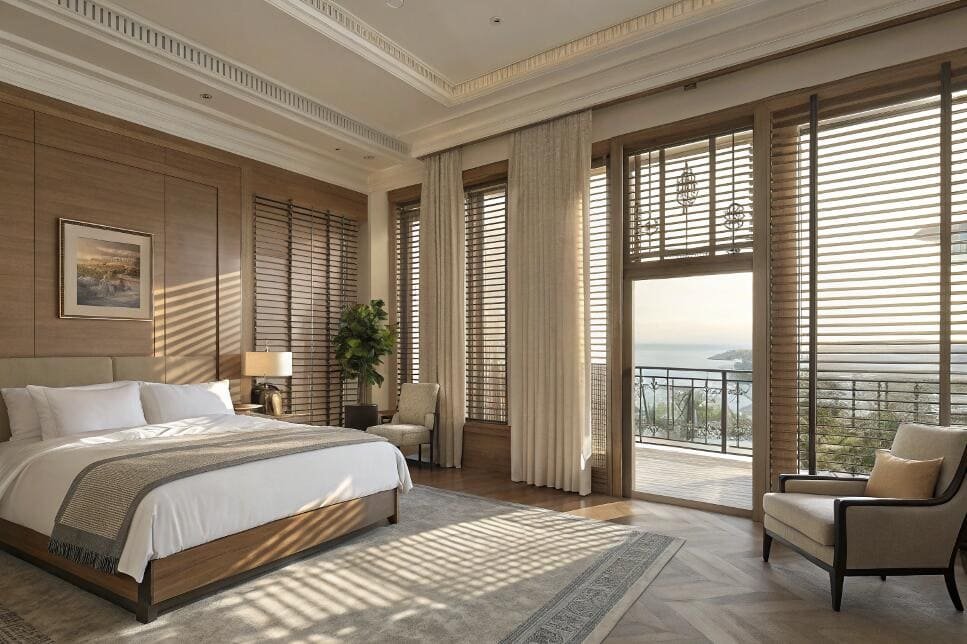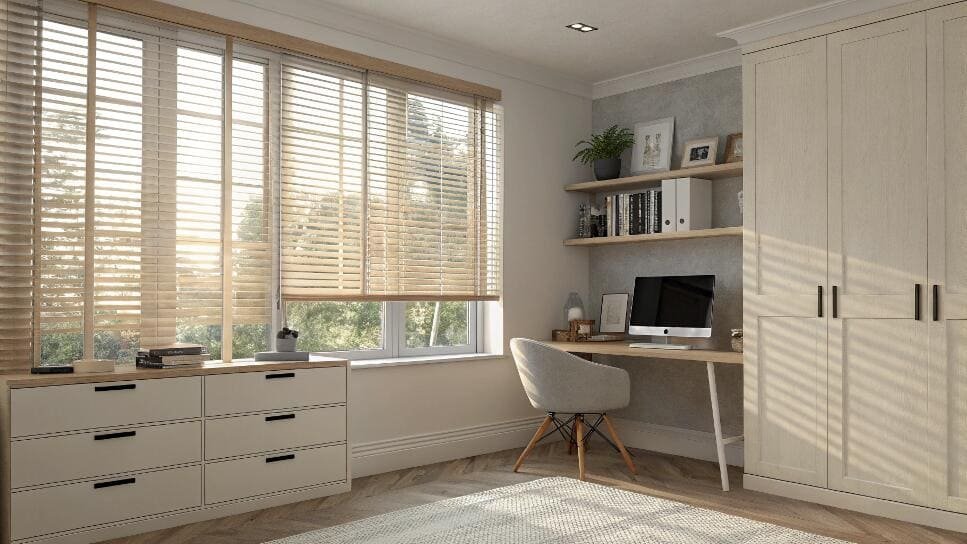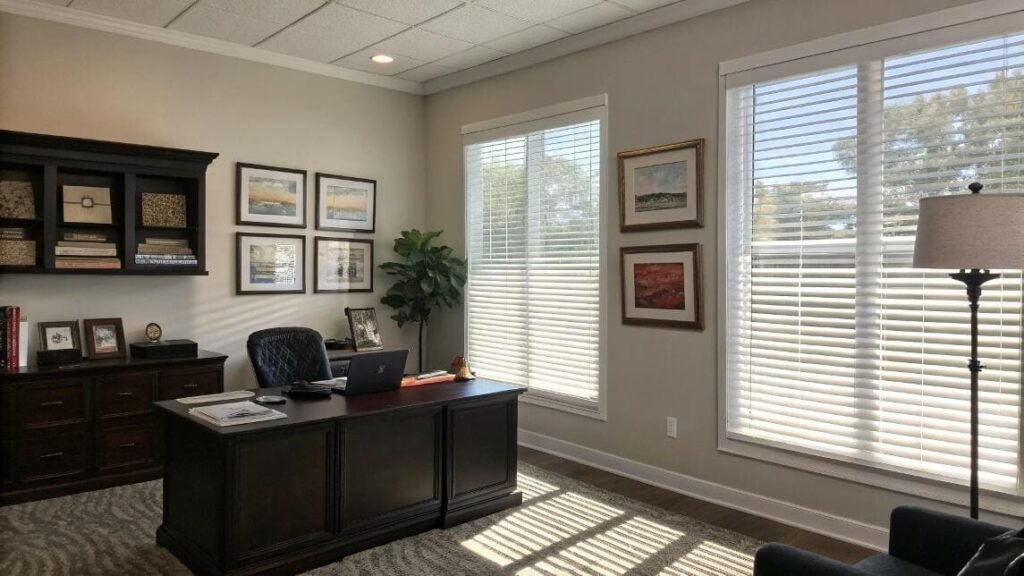You need a classic, reliable window solution for your project. Venetian blinds[^1] seem like a safe bet, but you worry about cleaning, tangled cords, and whether they look dated.
Venetian blinds offer supreme light control through tilting slats and a timeless design[^2]. Their main drawbacks are they can be difficult to clean, and the corded mechanisms can be cumbersome. High-quality materials and motorization are key to maximizing their benefits.

As a supplier focused on project success, I believe in this classic product. Venetian blinds have been around for centuries for one simple reason: they work exceptionally well. But a successful installation depends on knowing both their strengths and their weaknesses. For every designer like Emma who I work with, the goal is to choose a product that looks great on day one and performs flawlessly for years. Let's walk through the pros and cons so you can specify Venetian blinds with complete confidence.
What is the advantage of Venetian blinds?
You're looking for flexible and functional window coverings. Are Venetian blinds just a basic option, or do they have a standout feature that others lack?
Their unmatched advantage is precise and versatile light control. You can tilt, raise, or lower them to perfectly manage brightness, glare, and privacy in a way that no single-piece shade can match. They are a true multi-function solution.

The main advantage I always highlight is their incredible range of control. With a roller shade, your options are basically up or down. A Venetian blind gives you a whole spectrum of possibilities. Imagine a west-facing office. With the blind fully down, you can tilt the slats to block the harsh afternoon sun and eliminate screen glare, while still allowing ambient light to fill the room. You can angle them to bounce light off the ceiling, creating a bright space without direct heat gain. This ability to redirect light is something no other blind type does as well. Furthermore, their material versatility is a huge asset. You can specify them in warm, classic real wood for a high-end residential project, durable and moisture-proof faux wood for a kitchen or bathroom, or sleek, modern aluminum for a commercial space. This means you can get the same superior function with an aesthetic that fits virtually any design.
What makes venetian blinds a timeless design choice for various interior styles?
You want to avoid specifying a product that will look dated in a few years. How have Venetian blinds stayed so relevant for so long?
Their simple, clean horizontal lines give them a classic, architectural quality that transcends trends. They aren't tied to a specific pattern or color fad, allowing them to blend seamlessly into styles from minimalist to traditional.

Their timelessness comes from their simplicity. Like a classic piece of furniture, their form is driven by function, and that never goes out of style. The strong horizontal lines work with the geometry of a window, creating a look that feels structured and intentional. Think about it: a bold fabric pattern on a roller shade can look dated in five years, but the clean lines of a Venetian blind will always look right. I've supplied white wood Venetians for coastal-style homes where they feel light and airy, and I've supplied matte black aluminum blinds for industrial lofts where they look sharp and modern. The key is their adaptability. The blind itself provides the structure, and the material and color you choose allow it to harmonize with any décor. They don't shout for attention; they complement the overall design, which is the hallmark of a truly timeless product. Their long history, from Venetian trade routes to modern automated homes, proves they are a safe and sophisticated choice.
Do Venetian blinds add value?
You're managing a project budget. Are custom blinds just an expense, or can they be considered a genuine asset that adds value to a property?
Yes, high-quality, custom-fit[^3] Venetian blinds add tangible value. They are considered a permanent fixture and a significant upgrade over cheap, temporary solutions. Materials like real wood and features like motorization are very attractive to potential buyers.

This is a conversation I have often with developers and designers. Window coverings are one of the most visible finishes in a home or commercial space. When prospective buyers or tenants see custom-fit wood or faux wood Venetian blinds, it signals quality and attention to detail. It means they don't have to worry about the cost and hassle of installing window treatments themselves. This "move-in ready" feel adds real perceived value. Compare two identical apartments: one has cheap, ill-fitting plastic mini-blinds, and the other has sturdy, custom-made faux wood Venetian blinds. The second one immediately feels more premium and well-maintained. For commercial spaces, durable Venetian blinds represent a long-term, low-maintenance solution for light control, which is a value-add for any business tenant. Adding motorization[^4] takes it a step further, positioning the property as modern and high-tech, which is a clear selling point in today's market. They are an investment, not just an expense.
How do venetian blinds provide superior light control with adjustable slats?
You understand they're good for light control, but how exactly does it work? What specific benefits can you explain to your client?
The ability to tilt the horizontal slats gives you granular control over the direction and intensity of light. You can redirect harsh sun onto the ceiling for soft ambient light or angle it down to prevent glare, all while maintaining privacy.

Let’s get specific on how this works in practice, because this is the feature that solves so many common problems. The tilting mechanism isn't just about opening and closing; it's about redirecting energy. Imagine your client's home office. They need light to work, but the direct sun on their computer screen is a major issue. With Venetian blinds, you can provide a perfect solution that a simple shade cannot. You can lower the blind completely to cover the window, then tilt the slats upwards. This blocks the direct line of sight to the sun, eliminating glare completely. At the same time, the top surface of the slats acts like a series of mirrors, catching the sunlight and bouncing it up onto the ceiling. This fills the entire room with soft, usable, indirect light.
| Slat Angle | Light Effect | Privacy Level |
|---|---|---|
| Tilted Up | Bounces light off ceiling; soft, indirect room light. | High, blocks view from below. |
| Tilted Down | Directs light and heat towards the floor. | High, blocks view from above. |
| Horizontal | Maximum light and view-through. | Low. |
| Fully Closed | Maximum light blockage and privacy. | Highest. |
This level of control is simply unmatched.
What is the downside of Venetian blinds?
No product is perfect. To make an informed decision, you need to know the potential problems and frustrations your client might face.
The primary downside is cleaning; the horizontal slats are magnets for dust and can be tedious to maintain. The cord systems[^5] can also look cluttered, pose a safety risk, and can be heavy to operate on large windows.

Let's be upfront about the challenges, because managing client expectations is key. The number one complaint about Venetian blinds is, without a doubt, cleaning them. Each slat has a top and bottom surface where dust can settle, and wiping them one by one takes time. For a large project with dozens of windows, this is a significant maintenance consideration. The second major issue is the classic corded system. The combination of a lift cord and a tilt wand or cord can look messy and get tangled. More importantly, dangling cords are a well-known safety hazard for homes with young children or pets. Finally, there's the issue of weight and stack height. On large windows, real wood or faux wood blinds can be very heavy, making them physically difficult to lift every day. When they are fully raised, the compressed stack of slats is quite thick and can block a significant portion of the upper view. These are the main reasons we see so much interest in motorized solutions.
Can neighbours see through Venetian blinds?
Privacy is a non-negotiable for most clients, especially at night. How much can people actually see through the slats?
Yes, if the slats are left angled open, neighbors can easily see in, especially at night when your lights are on. However, when fully closed, they provide excellent privacy, blocking all direct lines of sight.

This is a critical point to clarify with your clients to prevent any issues after installation. The privacy level of Venetian blinds is entirely dependent on how they are used. During the day, the brighter light outside provides a good amount of privacy even with the slats tilted open. But at night, the script flips. A brightly lit interior is like a stage for anyone looking from the dark outside. If the blinds are left open, privacy is zero. The key is to close them correctly. For maximum privacy, the slats should be tilted until the front edge moves upwards, creating a tight seal. When closed this way, it is impossible for a neighbor to see any details inside. They might see a faint glow or a muted silhouette if someone is standing right next to the window, but that's it. For 99% of applications, this is more than sufficient privacy. The power is in the user's hands.
What are the cleaning and maintenance challenges of venetian blinds
You've specified the blinds; now, what practical advice can you give your client about keeping them clean without getting frustrated?
The main challenge is the time-consuming nature of cleaning each slat individually. Dust accumulates quickly, and if left, can combine with moisture or grease, making it harder to remove. Gentle, regular cleaning is the only effective strategy.

Setting realistic maintenance expectations is crucial for client satisfaction. I always suggest a simple two-part strategy. First is weekly dusting. This is non-negotiable to prevent buildup. The easiest way is to close the blinds fully, dust the entire surface with a large feather duster or a microfiber cloth, then reverse the tilt and dust the other side. This takes less than a minute per window and makes a huge difference. The second part is a deeper clean a few times a year. For this, a damp microfiber cloth is best. For aluminum or faux wood blinds, you can use a mild soap and water solution. For real wood, it’s critical to use a wood-safe cleaner and a cloth that is only lightly damp to avoid damaging the finish. What you want to avoid is letting dust build up until it becomes a bigger problem, especially in kitchens where it can mix with grease. Regular, light-touch cleaning is far less work than a major restoration job later.
What is the life expectancy of Venetian blinds?
Your reputation depends on specifying durable products. How many years of reliable service can a client realistically expect from their new Venetian blinds?
A well-made Venetian blind should last for 10 to 15 years, and often longer. The lifespan is determined by material choice, the quality of the headrail mechanism, and exposure to direct sun and humidity. Faux wood and aluminum are the most durable.

When we source products, we focus on the components that ensure longevity. The first factor is the slat material. Faux wood is nearly indestructible; it won't warp, crack, or fade, making it ideal for tough environments like bathrooms. Aluminum is also extremely long-lasting, though the slats can be bent by rough handling. Real wood has a very long life expectancy, but only if it's kept away from high humidity that can cause warping. The second, and arguably more important, factor is the quality of the headrail and its internal components. This is where cheap blinds fail. A low-quality plastic cord lock or tilt mechanism will wear out and break from daily use, rendering the blind useless even if the slats are fine. That's why investing in a product with a robust, heavy-duty headrail is critical. It's the engine of the blind, and it's what ensures smooth, reliable operation for years to come.
How do motorized venetian blinds address traditional operational limitations?
Tangled cords, heavy lifting, and inconsistent slat angles are the biggest complaints. Can technology really solve these fundamental problems?
Motorization is the perfect solution to the classic downsides of Venetian blinds. It provides effortless, one-touch control for both lifting and tilting, eliminates messy and unsafe cords, and allows for precise, uniform alignment across multiple windows.

This is where Venetian blinds enter the 21st century. As a smart shading provider, this is the solution I get most excited about because it directly fixes every major pain point. Think about the issues we discussed. Are the cords cluttered and unsafe? Motorization removes them entirely for a cleaner, safer design. Is the large faux wood blind in the living room too heavy to lift? A motor does it effortlessly with the press of a button. Is it impossible to get all four blinds in the boardroom tilted to the exact same angle? A motorized system can move them all in perfect unison to a pre-set favorite position. This is a game-changer for designers like Emma who value precision and a uniform aesthetic. It also opens up possibilities for hard-to-reach windows, like those in a high foyer or above a staircase. Motorization transforms the Venetian blind from a classic, manual product into a sophisticated, convenient, and intelligent part of the modern smart home or office.
Conclusion
Venetian blinds are a timeless choice with superior light control. While cleaning and cords can be a hassle, quality materials and motorization effectively solve these cons for a truly premium solution.
Upgrade Your Project with Smart, Timeless Blinds
Ready to specify Venetian blinds that offer classic style and modern convenience? Our team provides robust systems and expert guidance to ensure your project's success.
---
[^1]: Explore the advantages of Venetian blinds, including their light control and timeless design, to make an informed choice.
[^2]: Learn about the architectural quality of Venetian blinds that makes them a versatile choice for various interior styles.
[^3]: Find out how custom-fit Venetian blinds can enhance property value and appeal to potential buyers.
[^4]: Explore how motorization can solve common issues with traditional Venetian blinds, offering convenience and safety.
[^5]: Learn about the potential safety hazards and maintenance issues associated with traditional cord systems.Partner with VelaBlinds for Your Next Project
Smart window treatments shouldn't be complicated. After working with 500+ distributors and contractors worldwide, I've streamlined the process to get you quality products, competitive pricing, and reliable support - every time.
Why project professionals choose VelaBlinds:
- ✅ Fast, Accurate Quotes - Detailed specs and pricing within 24 hours
- ✅ Transparent Pricing - No hidden fees, volume discounts clearly outlined
- ✅ Quality Assurance - Direct partnerships with certified OEM manufacturers
- ✅ Project Support - Dedicated account manager from quote to delivery
Start your next project:
📧 Quick Quote: Send your requirements to info@velablinds.com
📱 Direct Contact: WhatsApp +86 137 2012 8317
🌐 Browse Solutions: https://velablinds.com/
📁 Product Resources: Access spec sheets, catalogs & project files
Jimmy Chen, Founder
"I built VelaBlinds to solve the real challenges I faced as a project buyer - long lead times, unclear specs, and unreliable suppliers. Let's discuss how we can power your projects with smarter blinds."
Serving distributors and contractors across North America, Europe, and Australia since 2018.




